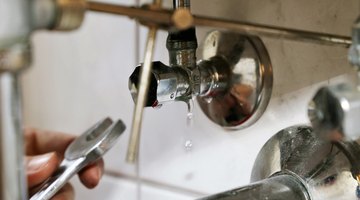What Is a Faucet Bleeder Valve?
While frost-proof sillcocks do not need to be drained to prevent freezing, a bleeder valve is an important part of winterizing a standard hose bib.

Bleeder valves are important when it comes to winterizing a home. The bleeder is located on a shut-off valve and allows water or air to be drained from a water pipe. While not all shut-off valves have bleeders, you are most likely to find them in the water pipes leading to outdoor hose bibs. Draining water from the pipe leading to the outside faucet will prevent wintertime freeze-ups and cracked pipes.
How a Bleeder Valve Works
A bleeder valve is a small hole in a shut-off valve, sealed with a rubber gasket and a threaded cap. There are several types of shut-off valves that have bleeders, including stop-and-waste valves and ball valves. The bleeder is not located in the center of the valve, but rather on the downstream side of the valve, or the side where the water is shut off when the valve is closed. The direction in which the valve should be installed is designated by an arrow on the valve. Once the valve is turned to the off position, the cap on the bleeder can be loosened or removed in order to drain water from the pipes.
Preventing Broken Pipes During Winter
A hose bib, also known as a sillcock or simply as an outside faucet, needs to be drained before the cold weather hits to prevent it from freezing. Simply turning the faucet off outside will not prevent freezing. Instead, the shutoff valve leading to the hose bib should be located inside the home and turned off. The hose bib should then be turned on, allowing water inside the valve to drain out. Then the bleeder cap should be loosened or removed by turning it clockwise, allowing it to drain out any remaining water from the pipe. Once the water has completely drained out, the bleeder cap should be tightened back up.
Frost-Proof Sillcocks
Most modern outside faucets are frost-proof, particularly those installed in cold climates. Frost-proof sillcocks are designed to withstand freezing without turning off the water or draining it from inside. Because of this, no bleeder valve is required on the pipe leading to the faucet. These valves feature a long stem and a gasket which closes the faucet from inside the house. A frost-proof faucet should be installed with a slight downward pitch to allow water to drain out when it is turned off. If the faucet is pitched the wrong way, water will remain in the stem and freeze in cold weather.
References
Resources
Writer Bio
Gary Sprague is a retired master plumber who started as an apprentice right out of high school and spent over 25 years in the family business. Most of his experience is in residential service and repair work, though he has also worked on new construction and commercial projects.
More Articles



